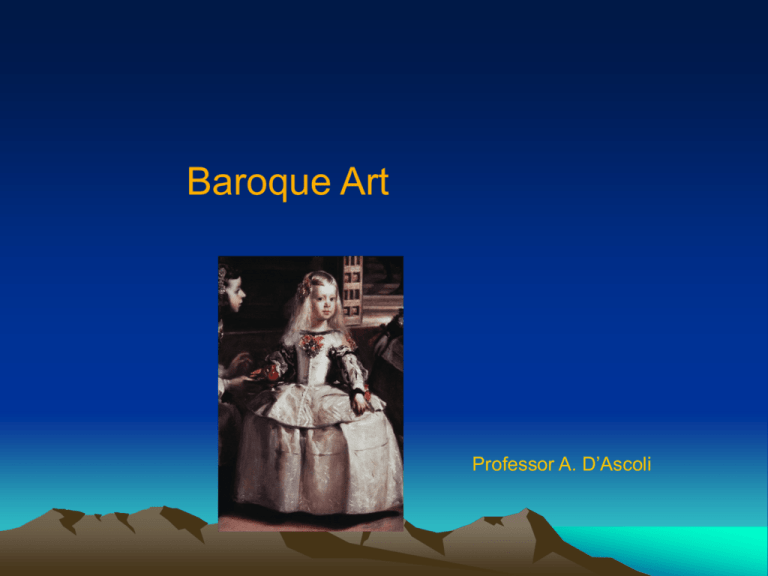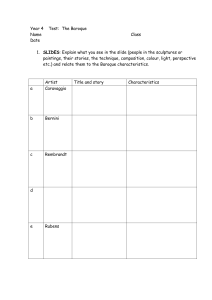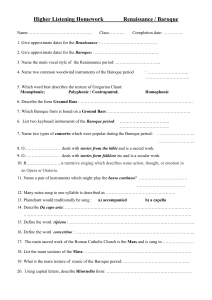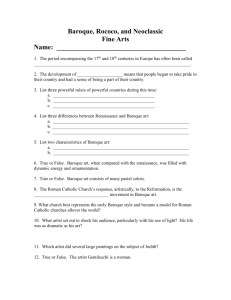4 - dascolihum.com
advertisement

Baroque Art Professor A. D’Ascoli Baroque Era • 1611 King James Bible is published • 1612 Foundation of New York by the Dutch • 1618 Beginning of the Thirty Years' War, which devastates much of the German region • 1619 First African slaves in Virginia • 1636 Foundation of Harvard College Baroque Art Characteristics • Symmetry still applies in architecture • Classical themes are replaced by religious ones in the classical style • Ornate, rich, lavish decorations inside and even outside • Attempt to show power of the Church • Emotional and violent portrayals • Strong contrast between light and dark colors • Trompe l’oiel (fool the eye) painted illusions Baroque Art • • • • • St Peter’s façade 1607 – 1615 Rome, Italy Artist: Carlo Maderno Changed Michelangelo’s Greek cross plan to Latin cross to accommodate large crowds • Largest of any church in Europe • Uses symmetrical order to connect the stories • Grand theatrical work to evoke power of Pope Baroque Art • • • • Plaza di San Pietro 1657 Rome, Italy Artist: Gianlorenzo Bernini • Plaza and colonnade represent the outstretched arms of the church encircling the faithful • Fountains align exactly Baroque Art • • • • • Baldacchino Rome, Italy 1624 – 1633 Artist: Bernini Altar that sits directly over St. Peter’s tomb • Bronze that this is made of was taken from the Pantheon’s roof by order of Barberini family Baroque Art • • • • • David 1623 Rome, Italy Artist: Bernini David caught in the middle of hurling the stone • Amazing skill is seen here in the expression, clothing and details of muscles and veins Baroque Art • Blessed Ludovica Albertoni • 1671-1674 • Rome, Italy • In San Francesco in Ripa • Shows her dying but in religious ecstasy at the same time • Not a saint yet, just beatified – claimed she could levitate and perform miracles Baroque Art • St. Theresa in Ecstasy • 1645 – 1652 • Rome, Italy • Artist: Bernini • Moment when angel is piercing St Theresa’s heart with the arrow of pure love of God, her face in divine pleasure (almost erotic) Bernini Bernini Baroque Art Baroque Art • San Carlo alle Quattro Fontane • 1638 – 1667 • Rome, Italy • Artist: Francesco Borromini • Church is on an intersection of narrow streets upon each corner is a fountain • Curvilinear surface is a unique aspect of Borromini’s work • Unique space called for unique church – columns of a made up classical order Francesco Borromini dome of San Carlo alle Quattro Fontane Rome, Italy 1665-1676 Dove painted in center represents the Holy Spirit Francesco Borromini Chapel of Saint Ivo College of the Sapienza Rome, Italy begun 1642 Most famous architect of the Baroque – he and Bernini were rivals Guarino Guarini Chapel of Santissima Sindone Turin, Italy 1667-1694 The Shroud of Turin rests here Baroque Art • • • • • Calling of St. Matthew 1599 – 1602 Rome, Italy Artist: Caravaggio Seated at a bar St Matthew is called to Jesus • The use of light makes this into a religious experience • Christ’s halo is barely visible • Tenebrism – in a dark manner Caravaggio Conversion of Saint Paul Cerasi Chapel, Santa Maria del Popolo Rome, Italy ca. 1601 oil on canvas approximately 7 ft. 6 in. x 5 ft. 9 in. Caravaggio is considered the greatest of the Italian Baroque painters Baroque Art • • • • • The Entombment 1603 Rome, Italy Artist: Caravaggio The stone slab is placed at eye height to give the viewer the sense that he/she is in the tomb ready to receive Christ’s body • Self portrait snuck in here • Caravaggio’s saints are regular people – common looking – an aspect that got him in a lot of trouble during his career Caravaggio David Victorious over Goliath oil on canvas 43 1/4 x 35 7/8 in. Heavily influenced his pupil Gentileschi Baroque Art • • • • • • • • Judith Slaying Holofernes 1620 Rome, Italy Artist: Artemesia Gentilischi In the style of Caravaggio’s tenebrism She was a female artist The light is used as a sort of spotlight to the main characters in the work A lot of her art portrayed violence – many say associated with her being sexually assaulted at 15 Artemisia Gentileschi Judith and her Maidservant ca. 1612-1613 oil on canvas 44 7/8 x 36 13/16 in. Note head in the basket Baroque Art • Triumph of St. Ignatius Loyola • 1691 – 1694 • Rome, Italy • Artist: Fra Andrea Pozzo • Ceiling of Sant’Ignazio in Rome • Illusionist Baroque style – flat ceiling line is gone – looks like it goes up into space Triumph of St. Ignatius Baroque Art • • • • The Bedroom 1663 Netherlands Artist: Pieter de Hooch • Baroque Dutch painting focused on details of everyday life • Painting above doorway to show art is in everyday life Baroque Art • • • • • Jolly Toper 1628 – 1630 Amsterdam, Netherlands Artist: Frans Hals Spontaneity is captured here instead of the usual stiff seated portraits • Balancing a glass of wine in one hand and gesturing with the other • He did not blend the brushstrokes Baroque Art • • • • • • Boy Playing a Flute 1630 – 1635 Amsterdam, Netherlands Artist: Judith Leyster A follower of Hals Depicted animated scenes from daily life like this one • Use of light and shadow Baroque Art • • • • • The Night Watch 1642 Amsterdam, Netherlands Artist: Rembrandt The event painted took place in the morning but years of candle soot and age caused it to be known as the Night Watch in error due to its darkening • All men in the painting paid equally for its commission • Composed along diagonal lines Baroque Art • • • • • Christ Preaching 1652 Amsterdam, Netherlands Artist: Rembrandt Even in his prints Rembrandt exhibited contrasts light and darkness • Set in Amsterdam’s Jewish ghetto Baroque Art • • • • • Self-Portrait 1669 Amsterdam, Netherlands Artist: Rembrandt His last self-portrait of well over 60 • Contours have become looser • Painting himself as he was – it was an insightful reflection not like the paintings of Durer at all Baroque Art • Young Woman with a Water Pitcher • 1664 – 1665 • Delft, Netherlands • Artist: Jan Vermeer • Ordinary daily life activities in ordinary surroundings was Vermeer’s signature style • The light shines in producing shadows in all its subtleties Jan Vermeer Girl with the Pearl Earring 1670-1675 oil on canvas 18 x 16 in. His most famous painting – even made a movie Baroque Art • • • • • The Love Letter 1669 – 1670 Amsterdam, Netherlands Artist: Jan Vermeer Composed in a series of rectangles formed in perspective • Paintings hang on the wall, a laundry basket and the letter itself adorn this painting Peter Paul Rubens Elevation of the Cross Antwerp Cathedral, Antwerp, Belgium 1610 oil on panel 15 ft. 2 in. x 11 ft. 2 in. Rubens focuses on musculature much like Michelangelo in his early work Baroque Art • Marie de’ Medici, Queen of France, Landing in Marseilles • 1622 – 1625 • Antwerp, Brussels • Artist: Peter Paul Rubens • Gained his fame from European royal courts, especially Marie de’ Medici • Full of drama for such an ordinary situation • Plump females were his trademark “Rubenesque” Peter Paul Rubens The Three Graces oil on canvas 87 in. x 71 1/4 in. Rubenesque – a term used to describe the Women that Rubens painted Baroque Art • Portrait of Charles I at the Hunt • 1635 • London, England • Artist: Anthony van Dyck • Painting captures the king’s attitude of control and calm while contrasting it with the unsettled horse and the struggling groom • Van Dyck was an assistant to Rubens originally Judith Leyster Self-Portrait ca. 1630 oil on canvas 2 ft. 5 3/8 in. x 2 ft. 1 5/8 in. A student of Rubens Baroque Art • • • • • Las Meninas (Maids of Honor) 1656 Madrid, Spain Artist: Diego Velazquez Both a family portrait and a genre scene at the same time • Velazquez himself (behind canvas) as well as the king and queen (in mirror at back of room) have all been placed in the painting surreptitiously as the princess and her maids pose • Considered his masterpiece and possibly the most recognizable painting in the world . Baroque Art • Rape of the Sabine Women • 1636 – 1637 • Paris, France • Artist: Poussin • Diagonals, and verticals aid in perspective • Figures seem frozen in a moment rather than fluid • Style that is meant to appeal to the mind not the eye Nicholas Poussin Et in Arcadia Ego ca. 1655 oil on canvas 2 ft. 10 in. x 4 ft. Became more famous in modern times because of Da Vinci Code and Rennes le Chateau mystery Baroque Art • Palace du Louvre East Façade • 1667 – 1670 • Paris, France • Artists: Louis Le Vau, Charles Le Brun & Claude Perrault • A return to strict classical forms began during the late Baroque era in France – it would develop into a style known as Neo-Classicism Baroque Art • Gardens at the Chateau of Versailles • 1662 – 1668 • Versailles, France • Artist: Andre le Notre • Natural world turned to geometric shapes in symmetrical patterns Baroque Art • Garden Façade Versailles • 1669 • Versailles, France • Artist: Louis le Vau • This is the rear of the palace at Versailles facing the gardens; strict classicism was still followed for this structure Versailles Baroque Art • • • • Hall of Mirrors 1680 Versailles, France Artists: Charles le Brun & Jules Hardoun-Mansart • 240 ft long but only 34 ft wide and 43 ft high it gives the appearance of a tunnel • The window side overlooks the gardens • Symbol of French Baroque elegance Jules Hardouin-Mansart Église de Dôme Church of the Invalides Paris, France 1676-1706 French military church and hospital Baroque Art • • • • • St. Paul’s Cathedral 1675 – 1700 London, England Artist: Christopher Wren A Baroque interpretation of the Pantheon of Rome • Columns are arranged in pairs – a characteristically Baroque feature • Also added a lantern to the dome • The 2 towers are also Baroque in style Balthasar Neumann interior of the pilgrimage chapel of Vierzehnheiligen near Staffelstein, Germany 1743-1772 German Baroque is extremely detailed Egid Asam Assumption of the Virgin monastery church at Rohr, Germany 1723 Light from window makes it a seemingly heavenly experience Baroque Art • • • • • Harpsichord 1658 Germany Artist: Jerome de Zentis In the Baroque era, the harpsichord was a key instrument used by both Bach and Handel in their compositions and performances • Strings were plucked not hammered by a mechanism inside Germain Boffrand Salon de la Princesse with painting by Charles-Joseph Natoire and sculpture by J.B. Lemoine Hôtel de Soubise, Paris, France 1737-1740 Considered by some to be Rococo – not Baroque Baroque Art • • • • Chapel of the Rosary 1690 Puebla, Mexico Inside Church of Santo Domingo • Baroque style pushed to the limits of design and decoration • Full of flourishes and gilded gold • • • • Baroque Art Frontispiece of Leviathan 1651 London, England Written by Thomas Hobbes • The body of the king is made up of his subjects referring to the social contract betweens government and the people • A supported government rules of over a well fortified land at peace • The Leviathan is seen as a defense of monarchial rule Baroque Art • • • • • Telescope 1609 Florence, Italy Artist: Galileo Galilei Galilei was able to contradict the Ptolemaic view of a geocentric universe by observing the motions of the heavens • He was excommunicated for his views and told to recant them publicly The end . . . Next lecture . . . The 18th century







